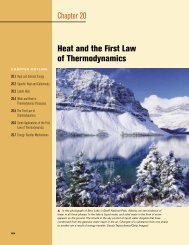15 • Oscillatory Motion - ECHSPhysics
15 • Oscillatory Motion - ECHSPhysics
15 • Oscillatory Motion - ECHSPhysics
You also want an ePaper? Increase the reach of your titles
YUMPU automatically turns print PDFs into web optimized ePapers that Google loves.
SECTION <strong>15</strong>.4 <strong>•</strong> Comparing Simple Harmonic <strong>Motion</strong> with Uniform Circular <strong>Motion</strong> 467<br />
The acceleration of P on the reference circle is directed radially inward toward O<br />
and has a magnitude v 2 /A 2 A. From the geometry in Figure <strong>15</strong>.<strong>15</strong>d, we see that the<br />
x component of this acceleration is 2 A cos(t ). This value is also the acceleration<br />
of the projected point Q along the x axis, as you can verify by taking the second<br />
derivative of Equation <strong>15</strong>.23.<br />
Quick Quiz <strong>15</strong>.6 Figure <strong>15</strong>.16 shows the position of an object in uniform<br />
circular motion at t 0. A light shines from above and projects a shadow of the object<br />
on a screen below the circular motion. The correct values for the amplitude and phase<br />
constant (relative to an x axis to the right) of the simple harmonic motion of the<br />
shadow are (a) 0.50 m and 0 (b) 1.00 m and 0 (c) 0.50 m and (d) 1.00 m and .<br />
Ball<br />
0.50 m<br />
Lamp<br />
Turntable<br />
Screen<br />
Figure <strong>15</strong>.16 (Quick Quiz <strong>15</strong>.6) An object moves in circular motion, casting a shadow<br />
on the screen below. Its position at an instant of time is shown.<br />
Example <strong>15</strong>.5 Circular <strong>Motion</strong> with Constant Angular Speed<br />
A particle rotates counterclockwise in a circle of radius 3.00 m<br />
with a constant angular speed of 8.00 rad/s. At t 0, the particle<br />
has an x coordinate of 2.00 m and is moving to the right.<br />
(A) Determine the x coordinate as a function of time.<br />
Solution Because the amplitude of the particle’s motion<br />
equals the radius of the circle and 8.00 rad/s, we have<br />
x A cos(t ) (3.00 m)cos(8.00t )<br />
We can evaluate by using the initial condition that<br />
x 2.00 m at t 0:<br />
2.00 m (3.00 m)cos(0 )<br />
cos 1 <br />
2.00 m<br />
3.00 m<br />
If we were to take our answer as 48.2° 0.841 rad,<br />
then the coordinate x (3.00 m)cos(8.00t 0.841) would<br />
be decreasing at time t 0 (that is, moving to the left). Because<br />
our particle is first moving to the right, we must<br />
choose 0.841 rad. The x coordinate as a function of<br />
time is then<br />
x <br />
Note that the angle in the cosine function must be in<br />
radians.<br />
(B) Find the x components of the particle’s velocity and acceleration<br />
at any time t.<br />
Solution<br />
v x dx<br />
dt<br />
a x dv<br />
dt<br />
<br />
<br />
(3.00 m)cos(8.00t 0.841)<br />
(3.00 m)(8.00 rad/s)sin(8.00t 0.841)<br />
(24.0 m/s)sin(8.00t 0.841)<br />
(24.0 m/s)(8.00 rad/s)cos(8.00t 0.841)<br />
(192 m/s 2 )cos(8.00t 0.841)<br />
From these results, we conclude that v max 24.0 m/s and<br />
that a max 192 m/s 2 .



